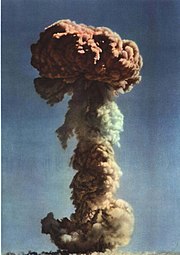預警即發射
| 核子武器 |
|---|
 |
|
|
預警即發射(英文:Launch on warning,縮寫:LOW)是一種核武器反擊策略:當探測到敵方核攻擊的預警信號時,在敵方導彈尚未引爆仍在空中飛行時,即發動核反擊。這一策略在冷戰期間蘇聯與美國的對峙中得到認可。隨着洲際彈道導彈的發明,預警即發射成為相互確保摧毀理論重要組成部分。據報道,美國的陸基導彈可以在總統決定後5分鐘內發射,潛射彈道導彈則可以在15分鐘內發射。[1]
歷史
[編輯]在洲際彈道導彈問世之前,美國戰略空軍司令部通過一項名為「鉻穹頂行動」(英文:Operation Chrome Dome)的計劃來始終保持多架轟炸機在空中巡邏。[2]一旦蘇聯對美國進行核打擊,在空中巡邏的空中的轟炸機會被命令飛往蘇聯用核彈頭轟炸預定目標。這些轟炸機通常是B-47或B-52,並有三條主要的飛行路線。通過保持轟炸機在空中巡航,即便第一次襲擊摧毀了地面設施,也能確保實施第二次襲擊。
在冷戰的高峰時期,美國還配備了特殊的波音EC-135飛機作為核武器的空中指揮中心。戰鬥指揮組中包括一名將軍或高級軍官,如果無法聯繫到總統,他有權下令進行報復性打擊。[3]
預警即發射的起源可追溯至美國總統艾森豪威爾提出的「積極控制」(英文:Positive Control)戰略,但真正成形則是隨着民兵導彈的引入。由於包括「民兵」在內的許多洲際彈道導彈(ICBM)都是從地下發射井發射的,這引發了一種擔憂:一國的首次核打擊可能會摧毀另一國的地面發射設施,從而使其無法進行反擊。
1997年,一位美國官員表示,美國擁有實施預警即發射的技術能力,但並無意採用這一戰略姿態。這一立場在1997年的總統核武器政策指令中並未發生改變。[4]
核戰略中有兩種主要選擇。一種選擇是「受攻擊後反擊」(retaliation after ride-out),即第二次打擊的國家在遭受攻擊後再發射其導彈。這種情況下,一部分核武庫難免會在攻擊中被摧毀,因此兩個超級大國都大力投資於提高核力量的生存能力,[5]包括為洲際彈道導彈(ICBM)建造加固的地下發射井,[6]以及部署潛射彈道導彈。
另一種選擇是「預警即發射」,即在對方導彈摧毀己方導彈前率先發射核導彈。這種能力的實現主要得益於導彈技術的進步,使得導彈能夠更快速地發射。[7]在20世紀70年代,這種能力通過雙方部署基於太空的發射探測技術進一步增強,美國部署了同步軌道的導彈預警衛星,而蘇聯亦部署了衛星監控。
解密文件表明,20世紀50年代末至70年代,預警即發射策略進入了美國的部分核政策。[7]1981年,美國的核策略有調整,規定在接收到蘇聯導彈來襲的信息後,美國「不應依賴於不可逆轉的方式發射我們的核力量」,但美國「必須做好準備,在收到蘇聯核攻擊開始的預警後,起飛可以召回的轟炸機部隊」。[8]
有一些策略可以削弱「預警即發射」策略的有效性。例如,首次打擊的一方可以使用一種稱為X射線壓制(X-ray pin-down)的技術來延緩對方的反擊。這種技術包括從近距離發射大量潛射導彈,以「低彈道」模式在數分鐘內抵達目標。這些導彈的彈頭被設定為每隔一分鐘左右在高空爆炸一次,從而顯著干擾被攻擊國家發射其洲際彈道導彈(ICBM)的能力。[9][10]
中國
[編輯]進入2020年代,據報道,中國的部分核力量已開始轉變為預警即發射的策略。[11][12]
參見
[編輯]參考
[編輯]- ^ Frequently Asked Questions about Taking Nuclear Weapons Off Hair-Trigger Alert (PDF) (報告). Union of Concerned Scientists. January 2015 [2024-11-29]. (原始內容存檔 (PDF)於2024-12-17).
- ^ Strategic Air Command. globalsecurity.org. [23 February 2001]. (原始內容存檔於2024-06-26).
- ^ EC-135, Looking Glass. Federation of American Scientists. (原始內容存檔於10 November 2013).
- ^ Cerniello, Craig. Clinton Issues New Guidelines on U.S. Nuclear Weapons Doctrine. Arms Control Today (Arms Control Association). November–December 1997 [11 January 2014]. (原始內容存檔於2024-12-11).
Bell said the press had incorrectly indicated that the PDD "still allows" the United States to launch nuclear weapons upon receiving warning of an attack. Bell emphasized that "there is no change in this PDD with respect to U.S. policy on launch on warning and that policy is that we do not, not rely on it." In fact, Bell said "in this PDD we direct our military forces to continue to posture themselves in such a way as to not rely on launch on warning—to be able to absorb a nuclear strike and still have enough force surviving to constitute credible deterrence." Bell pointed out that while the United States has always had the "technical capability" to implement a policy of launch on warning, it has chosen not to do so. "Our policy is to confirm that we are under nuclear attack with actual detonations before retaliating," he said.
- ^ Widder, Robert I. Launch on Warning: A Counter to the Arms Race. Air University Review. Vol. 21 no. 2. January–February 1970: 95–100. OCLC 56521794. (原始內容存檔於24 January 2017).
- ^ G, Jeffrey. Insuring Survivability: Basing the MX Missile. The Heritage Foundation (報告). May 27, 1980 [2024-11-29]. (原始內容存檔於2024-07-29).
- ^ 7.0 7.1 Burr, William (編). Launch on Warning: The Development of U.S. Capabilities, 1959–1979. George Washington University; National Security Archive. April 2001 [24 February 2011]. Electronic Briefing Book No. 43. (原始內容存檔於2015-03-01).
- ^ Reagan, Ronald, National Security Decision Directive 13, "Nuclear Weapons Employment Policy", Washington, D.C.: The White House, 13 October 1981 [2024-11-29], (原始內容存檔於2024-06-14)
- ^ Steinbruner, John. Launch under Attack. Scientific American. January 1984, 250 (1): 37–47. Bibcode:1984SciAm.250a..37S. JSTOR 24969276. doi:10.1038/scientificamerican0184-37.
- ^ Charles Mohr. "Pindown" tactic called peril to tightly packed MX missile. The New York Times. 21 July 1982 [15 February 2023]. (原始內容存檔於2024-07-29).
- ^ Hiim, Henrik Stålhane; Fravel, M. Taylor; Trøan, Magnus Langset. The Dynamics of an Entangled Security Dilemma: China's Changing Nuclear Posture. International Security. 2023-01-04, 47 (4): 147–187. ISSN 0162-2889. doi:10.1162/isec_a_00457
 (英語).
(英語).
- ^ A missile test by China marks its growing nuclear ambitions. The Economist. September 27, 2024 [2024-09-27]. ISSN 0013-0613. (原始內容
 存檔於September 27, 2024).
存檔於September 27, 2024).
